Intel’s Sandy Bridge i7-2820QM: Upheaval in the Mobile Landscape
by Jarred Walton on January 3, 2011 12:00 AM EST- Posted in
- Laptops
- Intel
- Sandy Bridge
- Compal
Mobile Sandy Bridge Gaming Performance
Sandy Bridge is clearly a faster CPU than the preceding Arrandale and Clarksfield offerings—that’s no surprise. The integrated graphics are also faster, but being faster than old Intel’s HD Graphics isn’t saying a whole lot. Then again, AMD’s old HD 4250 IGP isn’t much better and is long overdue for a replacement. We’ll talk about that in a second, but first here are the standard gaming performance results at our “Low” defaults. “Medium” detail will be on the next page.
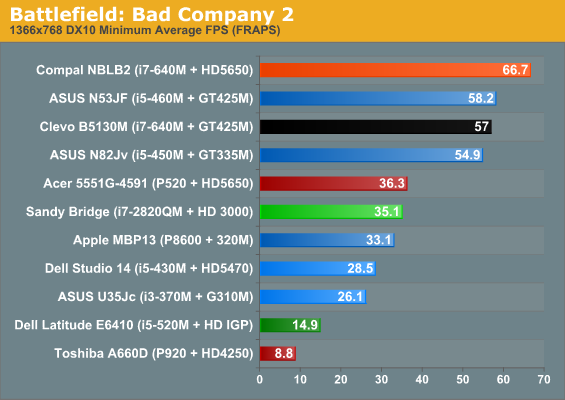
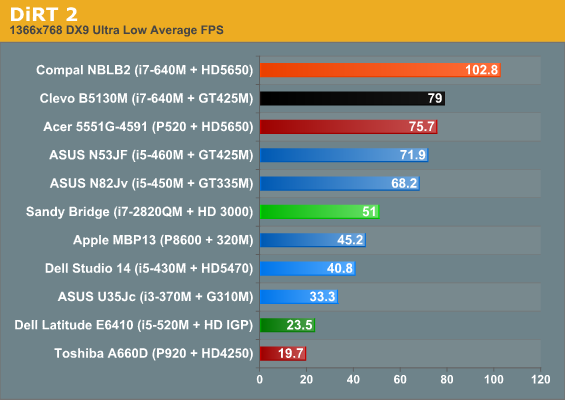
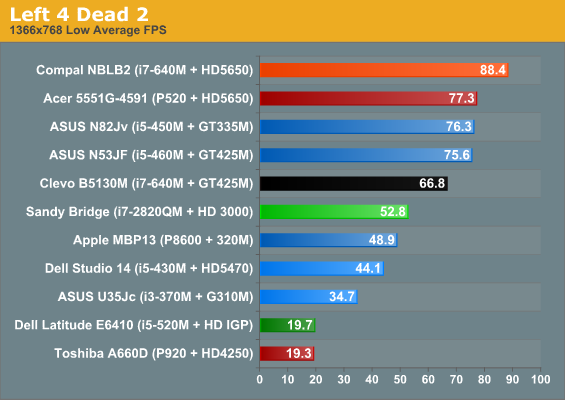
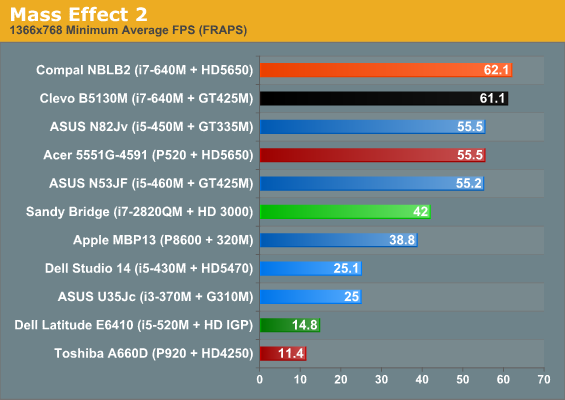
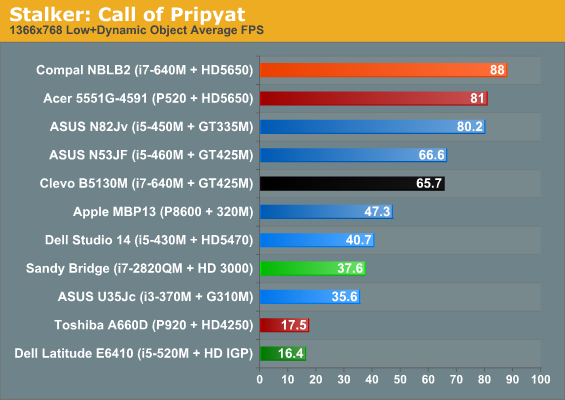
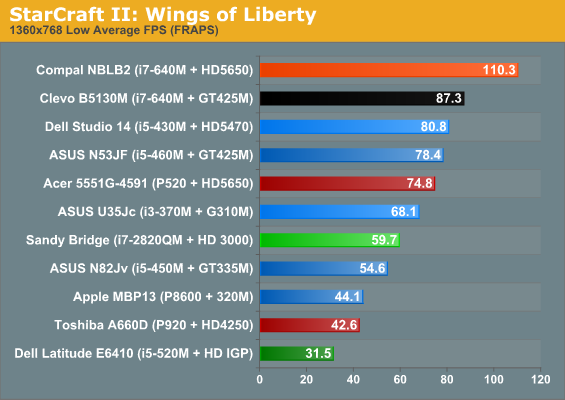

Let’s start by talking about compatibility problems with the Intel IGP: there were none! I know it’s been fashionable over the years to bash on Intel for horrible drivers that can’t run games, and the previous IGPs certainly still fall into that “too slow” category, but of our standard six test titles both Sandy Bridge and Arrandale IGPs loaded and ran every single title. That makes talk of performance meaningful, and that’s the bigger story by far.
Again, Sandy Bridge delivers playable performance in every single title at 768p and “Low” detail settings. What’s more, it actually surpasses the GeForce 320M in Apple’s MacBook Pro 13 in five out of six games (the exception being STALKER). Similarly, it beats the entry-level Radeon Mobility 5470 in four out of six games (STALKER and StarCraft II being the exceptions) and the G 310M in five out of six (SC2 came out ahead on the 310M).
All told, Intel’s HD Graphics 3000 checks in an average of 6% faster than HD 5470, 8% faster than GeForce 320M, 25% faster than G 310M, and a whopping 130% faster than both the previous generation HD Graphics and AMD’s HD 4250 (which are essentially tied in overall performance across the selected titles). Which is not to say it wins everywhere; even with a much slower Turion II P520 Processor, the HD 5650 still leads HD 3000 by 44%; shift the same GPU to an i7-640M to remove the CPU bottleneck and the 5650 beats HD 3000 by 130%. NVIDIA’s GeForce GT 425M also leads the 3000 by 46% on average, so discrete GPUs are by no means in danger of being replaced.
We didn't have time to do serious image quality comparisons, but subjectively there did appear to be a few games where the Intel IGP wasn't rendering at the same level of detail, but it's hard to say when you're not running at the native LCD resolution; we'll get into problems in a moment, but other than those mentioned we didn't have any serious complaints. After all, being able to run a game at all is the first consideration; making it look good is merely the icing on the cake.










66 Comments
View All Comments
skywalker9952 - Monday, January 3, 2011 - link
For your CPU specific benchmarks you annotate the CPU and GPU. I beleive the HDD or SSD plays a much larger role in those benchmarks then a GPU. Would it not be more appropriate to annotate the storage device used. Were all of the CPUs in the comparison paired with SSDs? If they weren't how much would that affect the benchmarks?JarredWalton - Monday, January 3, 2011 - link
The SSD is a huge benefit to PCMark, and since this is laptop testing I can't just use the same image on each system. Anand covers the desktop side of things, but I include PCMark mostly for the curious. I could try and put which SSD/HDD each notebook used, but then the text gets to be too long and the graph looks silly. Heh.For the record, the SNB notebook has a 160GB Intel G2 SSD. The desktop uses a 120GB Vertex 2 (SF-1200). W870CU is an 80GB Intel G1 SSD. The remaining laptops all use HDDs, mostly Seagate Momentus 7200.4 I think.
Macpod - Tuesday, January 4, 2011 - link
the synthetics benchmarks are all run at turbo frequencies. the scores from the 2.3ghz 2820qm is almost the same as the 3.4ghz i7 2600k. this is because the 2820qm is running at 3.1ghz under cinebench.no one knows how long this turbo frequency lasts. maybe just enough to finish cinebench!
this review should be re done
Althernai - Tuesday, January 4, 2011 - link
It probably lasts forever given decent cooling so the review is accurate, but there is something funny going on here: the score for the 2820QM is 20393 while the score for the score in the 2600K review is 22875. This would be consistent with a difference between CPUs running at 3.4GHz and 3.1GHz, but why doesn't the 2600K Turbo up to 3.8GHz? The claim is that it can be effortlessly overclocked to 4.4GHz so we know the thermal headroom is there.JarredWalton - Tuesday, January 4, 2011 - link
If you do continual heavy-duty CPU stuff on the 2820QM, the overall score drops about 10% on later runs in Cinebench and x264 encoding. I mentioned this in the text: the CPU starts at 3.1GHz for about 10 seconds, then drops to 3.0GHz for another 20s or so, then 2.9 for a bit and eventually settles in at 2.7GHz after 55 seconds (give or take). If you're in a hotter testing environment, things would get worse; conversely, if you have a notebook with better cooling, it should run closer to the maximum Turbo speeds more often.Macpod, disabling Turbo is the last thing I would do for this sort of chip. What would be the point, other than to show that if you limit clock speeds, performance will go down (along with power use)? But you're right, the whole review should be redone because I didn't mention enough that heavy loads will eventually drop performance about 10%. (Or did you miss page 10: "Performance and Power Investigated"?)
lucinski - Tuesday, January 4, 2011 - link
Just like any other low-end GPU (integrated or otherwise) I believe most users would rely on the HD3000 just for undemanding games in the category of which I would mention Civilization IV and V or FIFA / PES 11. This goes to say that I would very much like to see how the new Intel graphics fares in these games, should they be available in the test lab of course.I am not necessarily worried about the raw performance, clearly the HD3000 has the capacity to deliver. Instead, the driver maturity may come out as an obstacle. Firstly one has to consider the fact that Intel traditionally has problems with GPU driver design (relative to their competitors). Secondly, should at one point Intel be able to repair (some of) the rendering issues mentioned in this article or elsewhere, notebook producers still take their sweet time before supplying users with new driver versions.
In this context I am genuinely concerned about the HD3000 goodness. The old GMA HD + Radeon 5470 combination still seems tempting. Strictly referring to the gaming aspect I honestly prefer reliability and a few FPS' missing rather than the aforementioned risks.
NestoJR - Tuesday, January 4, 2011 - link
So, when Apple starts putting these in Macbooks, I'd assume the battery life will easily eclipse 10 hours under light usage, maybe 6 hours under medium usage ??? I'm no fanboy but I'll be in line for that ! My Dell XPS M1530's 9-cell battery just died, I can wait a few months =]JarredWalton - Tuesday, January 4, 2011 - link
I'm definitely interested in seeing what Apple can do with Sandy Bridge! Of course, they might not use the quad-core chips in anything smaller than the MBP 17, if history holds true. And maybe the MPB13 will finally make the jump to Arrandale? ;-)heffeque - Wednesday, January 5, 2011 - link
Yeah... Saying that the nVidia 320M is consistently slower than the HD3000 when comparing a CPU from 2008 and a CPU from 2011...Great job comparing GPUs! (sic)
A more intelligent thing to say would have been: a 2008 CPU (P8600) with an nVidia 320M is consistently slightly slower than a 2011 CPU (i7-2820QM) with HD3000, don't you think?
That would make more sense.
Wolfpup - Wednesday, January 5, 2011 - link
That's the only thing I care about with these-and as far as I'm aware, the jump isn't anything special. It's FAR from the "tock" it supposedly is, going by earlier Anandtech data. (In fact the "tick/tock" thing seems to have broken down after just one set of products...)This sounds like it is a big advantage for me...but only because Intel refused to produce quad core CPUs at 32nm, so these by default run quite a bit faster than the last gen chips.
Otherwise it sounds like they're wasting 114 million transistors that I want spent on the CPU-whether it's more cache, more, more functional units, another core (if that's possible in 114 million transistors) etc.
I absolutely do NOT want Intel's garbage, incompatible graphics. I do NOT want the addition complexity, performance hit, and software complexity of Optimus or the like. I want a real GPU, functioning as a real GPU, with Intels' garbage completely shut off at all times.
I hope we'll see that in mid range and high end notebooks, or I'm going to be very disappointed.